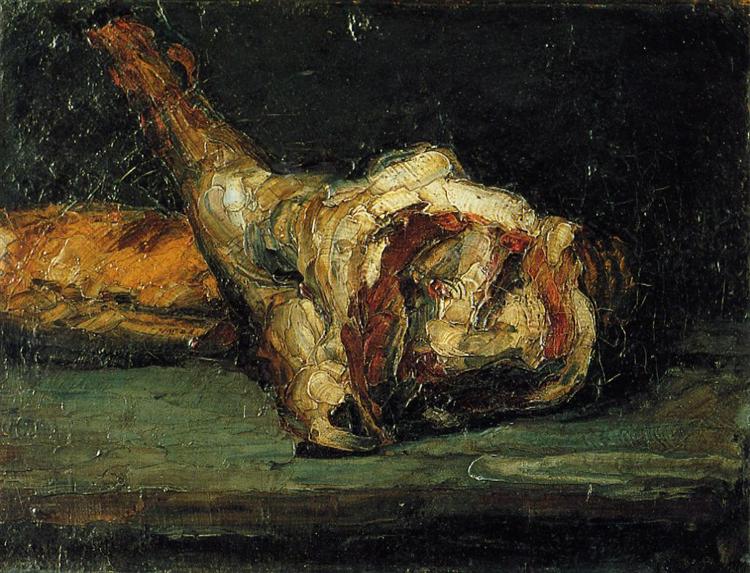Description
L'œuvre "Bodegón de Pan y Lembe de Cordero", peinte par Paul Cézanne en 1866, est un témoignage clair de la transition de l'artiste vers un style qui défierait les conventions de l'art traditionnel. Dans cette pièce, Cézanne nous offre une perspective unique sur la nature morte, un genre qu'il redéfinirait et qui influencerait plus tard le développement de l'art moderne.
Lors de l'observation de la peinture, un domaine incontestable de la composition est perçu. Cézanne organise les éléments de la table - un morceau de pain, une jambe d'agneau et une bouteille - dans un arrangement asymétrique mais harmonieux. Cette composition semble simple, mais est chargée de tensions visuelles qui se manifestent dans la façon dont les objets interagissent les uns avec les autres. La jambe d'agneau, avec sa texture riche et presque palpable, occupe un lieu central, attirant l'attention du spectateur. À côté de lui, la casserole, avec sa teinte la plus claire, sert de contraste qui non seulement met en évidence l'opulence de l'agneau, mais contribue également à un dialogue visuel avec la bouteille derrière.
Cézanne utilise la couleur de manière magistrale, explorant l'harmonie et la lumière à travers une palette caractérisée par la combinaison de tons terrestres et chauds. Le brun profond de l'agneau contraste avec la pâleur du pain et la luminosité de l'émeraude de la bouteille, créant une sensation de volume et à trois dimensions. Nous observons que les couleurs délimitent non seulement les objets, mais semblent également s'écouler, ce qui souligne l'idée d'interconnexion et d'intégration de ce qui est représenté. Cette façon d'approcher la couleur est un précurseur des explorations impressionnistes que Cézanne influencerait.
En termes de technique, Cezanne applique des coups de pinceau lâches et visibles, qui confèrent une énergie dynamique à l'œuvre. Cette utilisation abstraite du coup de pinceau suggère une recherche de l'essence des objets plutôt que de la simple représentation fidèle. Ainsi, la peinture est placée dans un espace où le naturalisme est lié à une approche plus moderne, où les objets sont transformés en signes d'une réalité plus profonde et émotionnelle.
Dans "Bodegón de Pan et la jambe de l'agneau", évidemment un moment de tous les jours est capturé, une scène simple qui devient une méditation sur la forme, la couleur et la texture. Cependant, cette simplicité apparente est un portail vers une complexité plus riche, où Cézanne prend les éléments de la vie quotidienne et leur donne un sens au-delà de l'immédiat.
Cézanne n'est pas seulement un maître de nature morte; Son approche fournirait également une influence significative pour les mouvements ultérieurs tels que le cubisme, où la fragmentation et la réorganisation de la forme deviendraient des éléments centraux. Ce travail est présenté comme un point d'intérêt pour cette tradition; Sa rupture avec la conventionnalité de son temps est à la fois subtile et radicale.
Grâce à "Bodegón de Pan et à la jambe de l'agneau", Cézanne nous invite à reconsidérer nos perceptions sur la réalité et tous les jours. L'œuvre est un témoignage de son génie créatif, un virage audacieux vers ce qui serait un nouveau langage visuel qui continue de résonner dans l'art contemporain. En fin de compte, cette peinture est plus qu'une simple nature morte; C'est une exploration de la vie elle-même, son essence, piégée dans la toile dans une danse entre l'éphémère et l'éternel.
KUADROS ©, une peinture célèbre sur votre mur.
Peintures à l'huile fabriquées à la main, avec la qualité des artistes professionnels et le sceau distinctif de KUADROS ©.
Service de reproduction des images avec garantie de satisfaction. Si vous n'êtes pas complètement satisfait de la réplique de votre peinture, nous remboursons votre argent à 100%.

